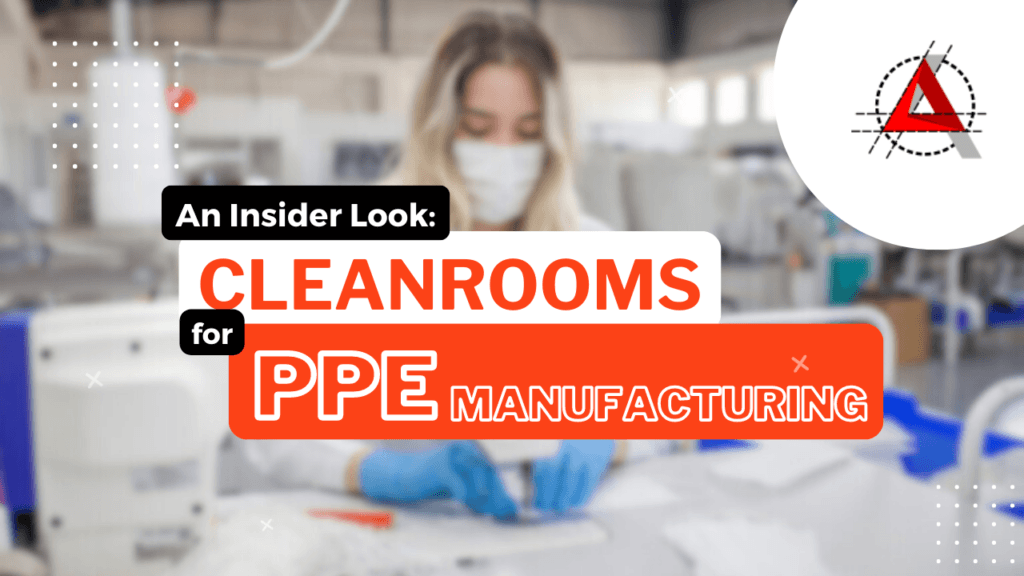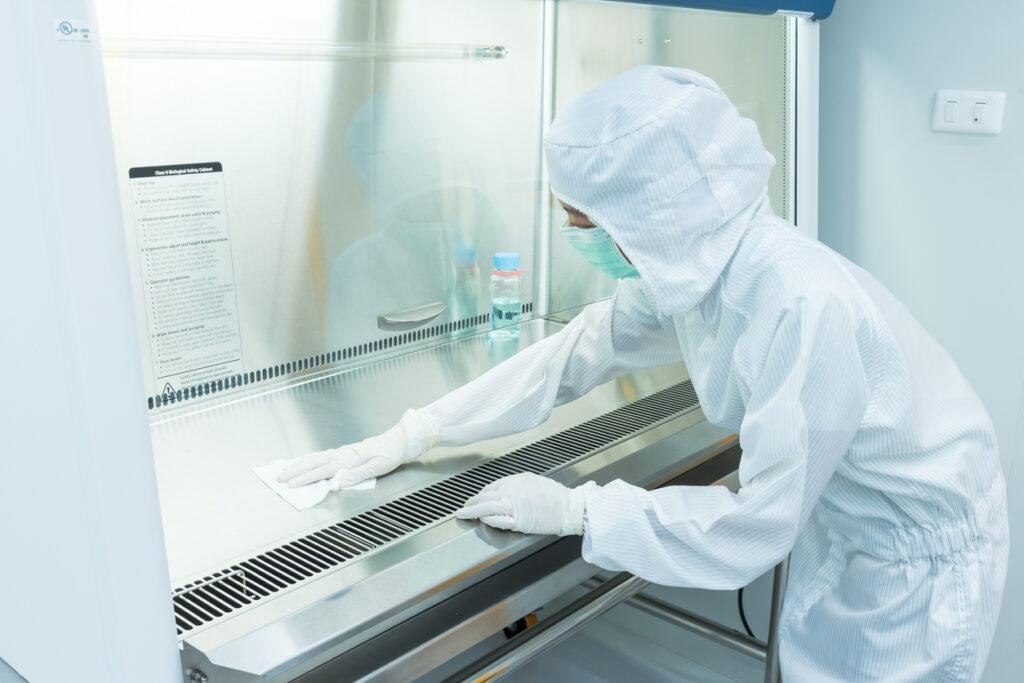An Insider Look: Cleanrooms For PPE Manufacturing

Cleanrooms are fully sanitized spaces that ensure PPE (personal protective equipment), masks and other important materials can be manufactured in a sanitized manner, certifying the safety of both medical professionals and patients. In fact, the Food and Drug Administration (FDA) requires that N95 masks, surgical masks, isolation gowns and other PPE be manufactured in cleanrooms. The FDA has gone as far as setting benchmarks for the manufacture of these products in cleanrooms, mandating the facilities and their employees to adhere by precise specifications for sanitization and cleanliness.
Why the FDA has High Standards for Mask and PPE Production
The FDA’s requirement that masks and PPE be manufactured in cleanrooms exists as these items are labeled and used as medical devices, both regulated and approved by the FDA. N95 masks have been certified for surgical and healthcare use, meaning they require more extensive and nuanced production controls. In fact, plenty of masks used by medical personnel mandate cleanroom rated materials. These materials are guaranteed not to shed fibers or lint that could potentially compromise the masks. It is interesting to note the FDA regulates surgical N95 respirator masks as well as gowns that qualify as surgical grade. However, masks that are not used for medical purposes are not classified as medical devices, and therefore, are not FDA regulated.
The FDA’s Standards for PPE Production in Cleanrooms
For the most part, the FDA does not provide highly specific rules and guidelines pertaining to requirements and build-specifications for cleanrooms. Rather, this group defers to CGMP or USP standards. The majority of CGMP and USP build requirements for cleanrooms are centered on ISO 14644-1. This is a baseline of sorts where cleanroom builds begin to prove compliant with the standards for masks as well as for PPE.
The Merits of Using a Cleanroom for Masks and PPE
A cleanroom for PPE manufacturing is a controlled environment in which pollutants such as dust, aerosol particles and airborne microbes are filtered. These are safe, clean, sanitized, and sterile places to manufacture medical equipment that do not pose a threat to the health of medical professionals or those in need of medical assistance. In fact, cleanrooms are subdivided into unique levels based on contamination in terms of the amount of particles permitted within the space per cubic meter. Furthermore, a cleanroom for PPE manufacturing controls variables ranging from air flow to temperature and humidity.
Cleanrooms are optimal spaces to make products such as masks and PPE as they ensure this protective gear is not tainted with viruses, bacteria, or other potentially harmful particles prior to their use in the field. The best cleanroom for PPE manufacturing facilities is carefully engineered to remove the highest level of pollutants, contaminants and particles from outdoor air. This outdoor air is circulated through a filter system using ULPA or HEPA filters, which decontaminate and clean the outdoor air in accordance with specific specifications. This filtered air is then moved directly into the cleanroom, ensuring masks and PPE can be manufactured without the potential for contamination. Furthermore, cleanrooms are designed to ensure the contaminated air within these spaces is moved outside of the room through registers, or at the bare minimum, recirculated to the filters allowing the process to restart.
Maintaining Cleanroom Cleanliness for Mask and PPE Production
Cleaning the air within a cleanroom for PPE manufacturing is only one piece of the sanitization puzzle that ensures PPE and masks can be manufactured without contamination of any sort. A concerted effort is necessary to maintain cleanroom cleanliness. Those who work in cleanrooms are aware of the fact that everything brought into this space has the potential to release particles into the air and onto surfaces. In fact, even people who walk into the room have the potential to carry contaminants that compromise the masks and PPE manufactured within the space.
This is precisely why those who work in cleanrooms where PPE and masks are made, wear protective garments themselves. After all, people are loaded with particles of various sorts, some of which will contaminate the cleanrooms as well as the PPE and masks made in those facilities. From flakes of skin to hair and beyond, there is a potential for particles of varying types to compromise items manufactured in these spaces. Every single person who enters a cleanroom wears prescribed protective gear ranging from gowns to gloves and in some cases, entire bunny suits (cleanroom suits) with goggles and a mask.
Some cleanrooms are controlled to the point that air showers are implemented to limit the number of particles that enter the space. Air showers in combination with the gowning room blow particles off individuals who plan to enter the cleanroom. This is quite the effective precaution to take to ensure those who enter the spaces where masks and PPE are manufactured do not carry potentially harmful particles in with them.
Additional Cleanroom Safeguards for PPE Manufacturing
It might be hard to believe yet the truth is furniture emits particles by simply sitting stationary within a room. Cleanroom furniture is carefully made to minimize the number of dust and other particles that gather on their surface. In other words, everyday furniture used in homes and offices will not suffice for a cleanroom. Furthermore, cleanrooms are often designed with sticky flooring. Such a specialized floor eliminates contaminants that are transported into the cleanroom by the wheels of equipment/carts and workers’ feet. Sticky flooring is highly effective in collecting such contaminants, quite durable and vastly superior to sticky mats. As long as sticky flooring in the cleanroom for mask manufacturing is cleaned properly and the standard for cleanliness is met, it will play a meaningful role in the production of contaminant-free masks and PPE.

Specific Gowning Techniques are Necessary for Cleanroom Mask and PPE Production
Gowning procedures are essential to making masks and PPE in cleanrooms that proves clean and safe for use. The proper cleanroom gowning techniques begin with an adherence to standard procedures. In short, every single person who enters the cleanroom where masks and PPE are manufactured should follow the same process. Cleanroom gowning spaces have designated areas such as an area for getting dressed, and a “cleaner” space. Employees should be aware of these boundaries and understand exactly where they should be positioned at each point through the gowning process.
From avoiding perfume and cosmetics to removing personal items, changing sneakers, wearing a bouffant and beyond, there are highly specific protocols for the proper gowning to guarantee the masks our medical professionals need is not tainted. Once the cleanroom workers are gowned properly, they can enter the cleanroom. However, masks, PPE and other equipment made in cleanrooms has the potential to be tainted if workers touch items before entering the cleanroom. If anything is touched, the employee must start the process all over again or at the bare minimum, change his or her gloves prior to working in a space that manufactures masks and/or PPE.
Frequently Asked Questions
What are the classification requirements for a mask manufacturing cleanroom?
The majority of CGMP and USP build requirements for cleanrooms are centered on ISO 14644-1. This is a baseline of sorts where cleanroom builds begin to prove compliant with the standards for masks as well as PPE. Generally, an ISO Class 8 cleanroom should satisfy classification requirements. However, a higher standard may be required depending on the application and final use of the PPE that is being manufactured.
How big should the cleanroom be?
Cleanroom size requirements for PPE are calculated based on how much mask manufacturing equipment is in the cleanroom. Ideally, we recommend keeping 3-4ft of distance around all equipment. There should also be enough room for a tablespace for a person to sit and work, as well as some space for raw material being moved in and out of the cleanroom.
Should any specific parameters be adhered to?
Cleanrooms for PPE manufacturing should control variables ranging from air flow to temperature and humidity. We recommend having a temperature of 20-22°C, 30-40% humidity and positive pressure inside the room to avoid any contamination.
What kind of cleanroom products are suitable to build this kind of cleanroom?
ACH Engineering provides a variety of cleanroom materials to build environments that are suitable for mask manufacturing. Click here to learn more about our cleanroom solutions and services.
GET IN TOUCH
Complete the form below to get in touch with our team.
